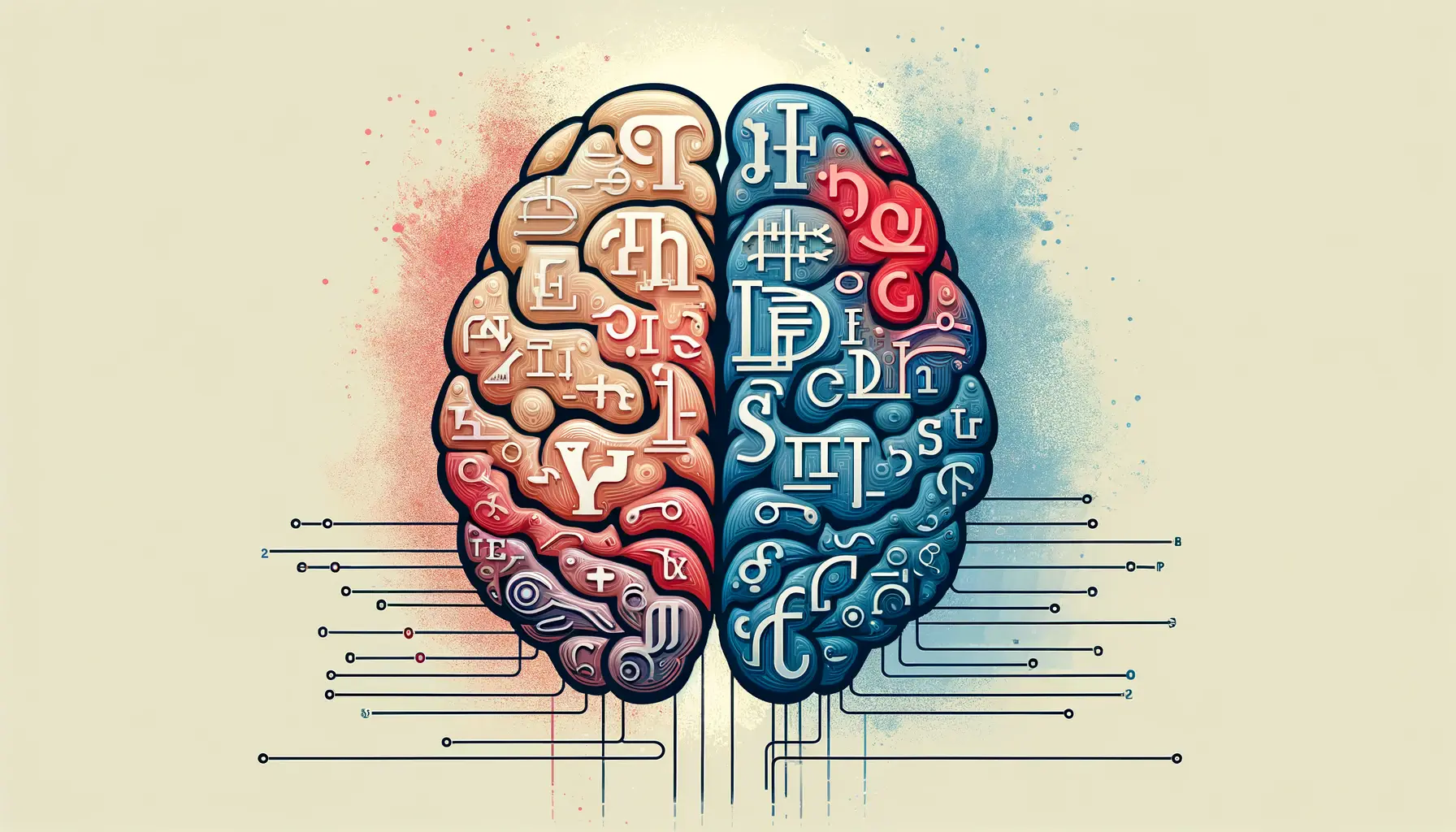The intricate world of typography holds more power over our daily interactions and perceptions than most of us realize.
At the heart of this world lies the typeface, a design element that transcends mere aesthetics to influence readability, user experience, and even the emotional and psychological response of its audience.
The choice of typeface can dramatically alter the message’s tone and intent, making it a crucial consideration in branding, marketing, and any form of visual communication.
Understanding the psychology behind typeface selection is not just about making content look attractive.
It’s about crafting experiences that align with the audience’s expectations, evoke the desired emotions, and drive engagement.
This exploration delves into the nuanced effects of typefaces on user behavior and perception, offering insights into how typography can be strategically used to enhance communication and interaction.
- Decoding the Typeface: An Introduction
- The Role of Typeface in User Experience
- Typography and Branding: A Strategic Alliance
- Impact of Typeface on User Decision Making
- Choosing the Right Typeface for Your Project
- Typography Trends and Innovations
- Typography in Digital Media and Web Design
- Embracing the Power of Typeface in Digital Communication
- FAQs on The Psychology of Typeface and Its Impact on Users
Decoding the Typeface: An Introduction
Typefaces, often confused with fonts, are the artistic expression of character design that encompasses a range of weights, styles, and variations.
Each typeface carries its own personality, capable of evoking specific emotions and creating an atmosphere before a single word is processed cognitively by the reader.
This initial impression can significantly affect how information is perceived and retained, making the choice of typeface a powerful tool in the hands of designers and marketers alike.
The impact of typeface on user experience and perception is profound.
It can alter reading speed, comprehension, and even the reader’s mood.
For instance, a study revealed that readers are more likely to believe a statement is true when it’s presented in a typeface that they perceive as trustworthy.
This psychological effect underscores the importance of selecting the right typeface for conveying specific messages or values.
Emotional Resonance of Typefaces
Every typeface has an emotional undertone that can subtly influence the reader’s feelings towards the content.
Serif typefaces, with their traditional and formal appearance, often evoke a sense of reliability and respectability.
They are commonly used in print media and academic publications, where credibility is paramount.
On the other hand, sans-serif typefaces, known for their clean and modern look, convey simplicity and approachability, making them a popular choice in digital platforms and casual communications.
The emotional impact of a typeface extends beyond its category.
The weight, width, and style of a typeface can further refine the emotional tone it sets.
Bold typefaces command attention and can convey strength or urgency, while italicized styles often denote emphasis or a personal touch.
This versatility allows designers to manipulate typeface characteristics to match the emotional tone of their content, enhancing the overall communicative power of their design.
The choice of typeface is a strategic decision that goes beyond aesthetics, deeply influencing how content is perceived and interacted with by users.
The Role of Typeface in User Experience
The influence of typeface on user experience (UX) is multifaceted, affecting not only the aesthetic appeal of a design but also its usability and accessibility.
A well-chosen typeface enhances readability, guides the user’s attention, and contributes to the navigability of a website or application.
Conversely, a poorly selected typeface can detract from the user experience, making content difficult to read and potentially driving users away.
Understanding the role of typeface in UX involves examining its impact on readability, mood setting, and brand perception.
By carefully selecting typefaces that align with the goals of a project, designers can create more effective and engaging user interfaces.
Enhancing Readability and Accessibility
- Readability: The legibility of a typeface directly influences how easily users can read and understand content. Simple, clean typefaces with adequate spacing are generally easier to read, especially in long texts or on digital screens.
- Accessibility: Typeface choice can also impact the accessibility of content for users with disabilities. For example, typefaces with distinct letterforms help users with dyslexia differentiate between similar-looking characters, improving their reading experience.
Setting the Mood and Tone
- Emotional Impact: The emotional resonance of a typeface can set the mood of a website or application, influencing how users feel while interacting with it. A playful typeface can create a light-hearted atmosphere, while a more serious one can set a professional tone.
- Contextual Relevance: The context in which content is presented also affects the appropriateness of a typeface. A typeface that works well for a luxury brand’s website might not be suitable for a children’s educational app.
Reinforcing Brand Identity
- Brand Consistency: Consistent use of a specific typeface across all brand materials helps reinforce brand identity and improves brand recognition among users.
- Brand Personality: Typeface selection is a powerful tool for conveying brand personality. A unique or custom typeface can differentiate a brand from its competitors and communicate its unique values and attributes.
The strategic use of typeface in UX design not only enhances the aesthetic appeal of a digital product but also its functionality and effectiveness in communicating with users.
Typography and Branding: A Strategic Alliance
The symbiotic relationship between typography and branding is undeniable.
Typography, especially the choice of typeface, plays a pivotal role in shaping a brand’s identity and how it is perceived by the target audience.
A well-executed typographic strategy can elevate a brand, imbuing it with personality and making it stand out in a crowded marketplace.
Branding is not just about logos and color schemes; it’s about telling a story and forging a connection with the audience.
The typeface chosen becomes the voice of the brand, conveying its values, tone, and ethos without a word being spoken.
This section explores how typography influences branding and the considerations involved in selecting the perfect typeface for a brand.
Conveying Brand Personality
The personality of a brand is a complex amalgamation of traits, values, and aspirations that it wants to be identified with.
Typography is a critical tool in expressing these characteristics.
For instance, a luxury brand might opt for a sleek, serif typeface to convey elegance and exclusivity, while a tech startup might choose a minimalist sans-serif to reflect innovation and modernity.
The choice of typeface communicates the brand’s personality at a glance, making it a crucial branding decision.
Moreover, the emotional impact of typefaces, as discussed earlier, means that the right typeface can evoke the desired emotional response from the target audience, aligning the brand’s identity with the audience’s expectations and preferences.
Building Brand Recognition
- Memorability: A distinctive typeface can make a brand more memorable. When consumers can easily recall a brand’s visual identity, including its typography, the brand stands a better chance of being the first choice when purchasing decisions are made.
- Consistency: Using the same typeface across all touchpoints — from the website and social media to packaging and advertising — creates a cohesive brand experience. This consistency helps reinforce brand recognition and loyalty.
Enhancing Brand Differentiation
In a competitive market, differentiation is key to standing out.
Typography can be a powerful differentiator, especially when brands in the same industry tend to follow similar visual trends.
A unique or custom typeface can serve as a visual marker that sets a brand apart from its competitors, signaling to consumers that the brand offers something different.
This differentiation is not just about being different for the sake of it; it’s about using typography to highlight the unique value proposition of the brand, making it clear why consumers should choose this brand over others.
The strategic integration of typography in branding is not merely a design choice but a business strategy that can significantly impact a brand’s market position and consumer perception.
Impact of Typeface on User Decision Making
The influence of typeface on user decision-making is a subtle yet powerful force in the digital landscape.
Every day, consumers are bombarded with choices, and the typeface used in marketing materials, websites, and product packaging can sway their decisions in ways they might not consciously realize.
This section delves into the psychological underpinnings of how typeface affects user choices and the implications for businesses and designers.
Understanding the cognitive processes triggered by different typefaces can help brands more effectively guide user decisions, from clicking a call-to-action button to choosing one product over another.
The right typeface can enhance message clarity, reinforce brand trust, and ultimately, influence purchasing behavior.
Enhancing Message Clarity
Clarity in communication is paramount, especially in an age of information overload.
A typeface that enhances readability and comprehension can make the difference between a message that is absorbed and acted upon and one that is overlooked.
For example, a clear, legible typeface in an online advertisement can make the offer more understandable, leading to higher conversion rates.
Conversely, a decorative or complex typeface might detract from the message, causing potential customers to lose interest.
Moreover, the congruence between a typeface and the message it conveys can amplify the message’s effectiveness.
A typeface that aligns with the product’s attributes or the brand’s personality can make the communication more persuasive, encouraging positive user decisions.
Reinforcing Brand Trust
Trust is a critical factor in user decision-making.
Typeface can play a significant role in building or eroding trust.
A professional, well-chosen typeface can lend credibility to a brand, making users more likely to trust the information presented and, by extension, the brand itself.
This trust can be particularly influential in industries where credibility is crucial, such as finance, health, and education.
On the other hand, a mismatched or inappropriate typeface can raise doubts about a brand’s reliability or professionalism, potentially deterring users from engaging further.
Thus, the careful selection of typeface is essential in cultivating a trustworthy brand image.
Influencing Purchasing Behavior
The psychological impact of typeface extends to purchasing behavior.
Certain typefaces can evoke emotional responses that align with the desired action, such as excitement for a sale or calmness for a wellness product.
By tapping into these emotional cues, brands can subtly guide users toward making a purchase.
Additionally, the uniqueness of a typeface can make a product stand out on a crowded shelf or a busy online marketplace.
A distinctive typeface can catch the user’s eye, making them more likely to consider the product and, ultimately, make a purchase.
The strategic use of typeface in user interfaces and marketing materials is not just an aesthetic decision but a psychological tool that can significantly influence user decision-making and behavior.
Choosing the Right Typeface for Your Project
Selecting the appropriate typeface for a project is a critical decision that can significantly impact its success.
This choice goes beyond personal preference or design trends; it involves understanding the project’s goals, the target audience, and the psychological effects of different typefaces.
Here, we explore key considerations and steps to ensure the chosen typeface aligns with the project’s objectives and enhances its overall impact.
Making an informed typeface selection requires a blend of aesthetic judgment and strategic thinking.
By considering the factors outlined below, designers and marketers can select a typeface that not only looks good but also supports the project’s goals and resonates with the intended audience.
Understanding the Project’s Goals
- Message and Tone: The typeface should complement the message’s tone, whether it’s formal, casual, playful, or serious. Matching the typeface to the tone helps ensure the message is conveyed effectively.
- Brand Identity: The typeface should reflect the brand’s personality and values. It’s an extension of the brand’s visual identity and plays a crucial role in brand recognition.
Knowing Your Audience
- Demographics: Consider the age, gender, and cultural background of the target audience. Different groups may respond differently to certain typefaces.
- Preferences and Expectations: Understand the audience’s preferences and expectations. A typeface that resonates with the audience can enhance engagement and readability.
Evaluating Typeface Characteristics
- Legibility and Readability: Choose a typeface that is easy to read in various sizes and on different devices. This is especially important for long texts and digital platforms.
- Emotional Impact: Consider the emotional undertones of the typeface and how they align with the project’s message and goals. The right emotional resonance can enhance the effectiveness of the communication.
Testing and Iteration
Once potential typefaces have been identified, it’s crucial to test them in context.
This involves creating mockups or prototypes and evaluating how the typeface performs in real-world scenarios.
Consider factors such as:
- Visibility: Ensure the typeface is legible at various sizes and distances.
- Compatibility: Check the typeface’s compatibility across different browsers and devices to ensure a consistent user experience.
- Flexibility: The typeface should work well in different weights and styles to accommodate various design needs.
Iterative testing allows for adjustments based on feedback and performance, ensuring the final typeface choice supports the project’s objectives and resonates with the target audience.
Selecting the right typeface is a process that combines art and science, requiring a deep understanding of the project’s goals, audience, and the subtle nuances of typographic design.
Typography Trends and Innovations
The dynamic field of typography is always evolving, with new trends and innovations continually shaping how typefaces are designed, used, and perceived.
Staying abreast of these changes can inspire designers to experiment with new styles and approaches, ultimately enhancing the effectiveness and appeal of their projects.
This exploration into current typography trends and innovations highlights the creative possibilities and technological advancements driving the future of typeface design.
Understanding these trends is crucial for designers looking to create fresh, relevant, and engaging designs that resonate with today’s audiences.
Here, we delve into some of the most influential trends and innovations in typography.
Responsive and Variable Fonts
- Responsive Typography: With the proliferation of devices and screen sizes, responsive typography has become essential. This approach involves adjusting typeface size, spacing, and layout to ensure optimal readability and user experience across all devices.
- Variable Fonts: Variable fonts are an innovative technology that allows a single font file to behave like multiple fonts, offering a range of weights, widths, and styles. This flexibility enables more dynamic and responsive design possibilities, reducing load times and enhancing performance on the web.
Handwritten and Custom Typefaces
- Handwritten Fonts: There’s a growing trend towards using handwritten or hand-drawn typefaces, which add a personal, authentic touch to designs. These fonts are particularly popular in branding, packaging, and editorial design, where a unique, human element is desired.
- Custom Typefaces: More brands are investing in custom typefaces to differentiate themselves and reinforce their identity. Custom fonts allow for complete control over the brand’s typographic voice, ensuring consistency and distinctiveness across all touchpoints.
Experimental Typography
Designers are increasingly experimenting with unconventional layouts, compositions, and typeface combinations.
This experimental approach often involves breaking traditional typographic rules to create eye-catching, memorable designs.
Techniques such as layering, text masking, and animated typography are being used to add depth, movement, and interest to digital and print projects.
While trends provide valuable insights into the direction of typography, it’s important for designers to balance trendiness with functionality and readability.
The best typographic designs are those that not only capture the audience’s attention but also enhance the communication and user experience.
Embracing new trends and innovations in typography can provide designers with the tools and inspiration needed to push boundaries, create more engaging experiences, and convey messages in visually compelling ways.
Typography in Digital Media and Web Design
The advent of digital media and the proliferation of web design have significantly expanded the role of typography in creating immersive, interactive experiences.
In the digital realm, typography does more than convey information; it engages users, directs their journey through a website or application, and contributes to the overall aesthetic and usability of the digital environment.
This section explores the critical aspects of typography in digital media and web design, highlighting its importance in enhancing user engagement and communication.
As digital platforms become increasingly central to our daily lives, the way we interact with text evolves.
Designers must navigate the challenges and opportunities presented by digital media to leverage typography effectively, ensuring that it serves both functional and aesthetic purposes.
Web Typography Best Practices
- Legibility on Screens: Ensuring text is legible across different devices and screen sizes is paramount. This includes selecting typefaces that are clear and readable at various resolutions and implementing responsive design principles to adapt typography to the user’s device.
- Contrast and Color: Adequate contrast between text and background colors is essential for readability and accessibility. Designers must consider users with visual impairments and ensure that text is easily distinguishable from its background.
- Loading Times: The performance of web fonts is a critical consideration. Heavy font files can slow down website loading times, negatively impacting user experience. Optimizing font files and using web-friendly formats can mitigate these issues.
Interactive Typography
Interactive typography introduces an element of engagement and dynamism to digital media.
Techniques such as hover effects, animation, and variable fonts can transform static text into an interactive experience, encouraging user interaction and enhancing the storytelling aspect of digital design.
These techniques not only capture the user’s attention but also provide opportunities for creative expression and innovation in web design.
Moreover, interactive typography can guide users through a digital interface, highlighting important information and facilitating navigation.
By making typography an active element of the design, digital media can create more engaging and memorable user experiences.
Accessibility and Inclusivity
Typography in digital media also plays a crucial role in accessibility and inclusivity.
Designers must consider the diverse needs of users, including those with disabilities, when choosing typefaces and designing text layouts.
Accessible typography ensures that digital content is inclusive, reaching a wider audience and providing equal access to information and services.
Implementing best practices for accessible typography, such as using alt text for images containing text, providing sufficient contrast, and ensuring compatibility with screen readers, is essential in creating digital media that is truly for everyone.
Neglecting typography in digital media and web design can lead to poor user experiences, decreased engagement, and barriers to accessibility. By prioritizing typography, designers can create digital environments that are not only visually appealing but also user-friendly and inclusive.
Embracing the Power of Typeface in Digital Communication
The journey through the psychology of typeface and its profound impact on users underscores the pivotal role typography plays in shaping our digital experiences.
From enhancing readability and reinforcing brand identity to influencing user decision-making, the strategic selection of typeface is a testament to the nuanced interplay between design and psychology.
As we navigate the vast landscape of digital media, the thoughtful application of typography principles emerges as a cornerstone of effective communication and engagement.
The Essence of Typeface in User Experience
At the heart of user-centered design lies the careful consideration of typeface, which goes beyond mere aesthetics to touch upon the very essence of user experience.
The choice of typeface can make content more accessible and digestible, thereby fostering an inclusive digital environment that welcomes users of all backgrounds and abilities.
By prioritizing legibility, contrast, and emotional resonance, designers can craft experiences that resonate deeply with the audience, encouraging interaction and exploration.
Typography as a Branding Powerhouse
Branding in the digital age is inextricably linked to the art of typography.
A brand’s typeface serves as its voice, carrying with it the weight of the brand’s personality, values, and aspirations.
The consistency and distinctiveness of this typographic voice across all platforms play a crucial role in building brand recognition and loyalty.
In this context, the selection of a typeface becomes a strategic decision that can significantly influence a brand’s position in the competitive digital marketplace.
Future Trends and Innovations in Typography
- The evolution of responsive and variable fonts is set to redefine the boundaries of web design, offering unprecedented flexibility and adaptability.
- Handwritten and custom typefaces continue to gain traction, providing a unique avenue for brands to express their individuality and connect with users on a personal level.
- Experimental typography challenges conventional design norms, encouraging creativity and innovation in the pursuit of captivating and engaging digital experiences.
In conclusion, the psychology of typeface and its impact on users is a multifaceted domain that extends far beyond the surface level of design.
It encompasses the strategic use of typography to enhance user experience, convey brand identity, and adapt to the ever-changing trends and innovations in digital media.
As we move forward, the thoughtful integration of typeface in digital communication will remain a key driver of engagement, accessibility, and overall success in the digital realm.
Quality web design is key for a great website! Check out our service page to partner with an expert web design agency.
FAQs on The Psychology of Typeface and Its Impact on Users
Explore common questions about how typeface influences user perception and behavior in digital environments.
Typeface can significantly influence how users perceive content, affecting readability, mood, and even the trustworthiness of the information presented.
Yes, the choice of typeface can affect website usability by enhancing or detracting from readability, navigation, and overall user experience.
Typeface is crucial in branding, as it conveys the brand’s personality, values, and professionalism, contributing to brand recognition and differentiation.
Typeface can subtly guide user decisions by evoking specific emotions or associations, thereby affecting their choices and actions on a website or application.
Best practices include considering readability, brand alignment, audience preferences, and the emotional impact of the typeface on the intended message.
Current trends include the use of responsive and variable fonts, custom typefaces for branding, and experimental typography to engage users.
Typeface plays a key role in web accessibility by enhancing readability for users with visual impairments and ensuring content is perceivable by all.
While challenging, the emotional impact of a typeface can be assessed through user feedback, A/B testing, and studying user interaction patterns.










